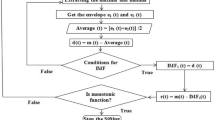Abstract
Epilepsy is among the most common brain disorders. Approximately 25–30% of epilepsy patients remain unresponsive to anti-epileptic drug treatment, which is the standard therapy for epilepsy. In this study, we apply optimization-based data mining techniques to classify the brain's normal and epilepsy activity using intracranial electroencephalogram (EEG), which is a tool for evaluating the physiological state of the brain. A statistical cross validation and support vector machines were implemented to classify the brain's normal and abnormal activities. The results of this study indicate that it may be possible to design and develop efficient seizure warning algorithms for diagnostic and therapeutic purposes.
Similar content being viewed by others
References
Begley, C., J. Annegers, D. Lairson, T. Reynolds, and W. Hauser. (1994). “Cost of Epilepsy in the United States: A Model Based on Incidence and Prognosis.” Epilepsia, 35(6), 1230–1243.
Begley, C., M. Famulari, J. Annegers, D. Lairson, T. Reynolds, S. Coan, S. Dubinsky, M. Newmark, C. Leibson, E. So, and W. Rocca. (2000). “The Cost of Epilepsy in the United States: An Estimate from Population-Based Clinical and Survey Data.” Epilepsia, 41(3), 342–351.
Chaovalitwongse, W., P. Pardalos, L. Iasemidis, D.-S. Shiau, and J. Sackellares. (2003). “Applications of Global Optimization and Dynamical Systems to Prediction of Epileptic Seizures.” In P. Pardalos, J. Sackellares, L. Iasemidis, and P. Carney, (Eds). Quantitative Neuroscience, pp. 1–36. Kluwer.
Chaovalitwongse, W., P. Pardalos and O. Prokoyev. (2004). “A New Linearization Technique for Multi-quadratic 0–1 Programming Problems.” Operations Research Letters, 32(6), 517–522.
Elger, C. and K. Lehnertz. (1998). “Seizure Prediction by Non-Linear Time Series Analysis of Brain Electrical Activity.” European Journal of Neuroscience, 10, 786–789.
Iasemidis, L. (1991). “On the Dynamics of the Human Brain in Temporal Lobe Epilepsy.” PhD thesis, University of Michigan, Ann Arbor.
Iasemidis, L., P. Pardalos, J. Sackellares, and D.-S. Shiau. (2001). “Quadratic Binary Programming and Dynamical System Approach to Determine the Predictability of Epileptic Seizures.” Journal of Combinatorial Optimization, 5, 9–26.
Iasemidis, L. and J. Sackellares. (1991). “The Evolution with Time of the Spatial Distribution of the Largest Lyapunov Exponent on the Human Epileptic Cortex.” In D. Duke and W. Pritchard (Eds.), Measuring Chaos in the Human Brain, pp. 49–82. World Scientific.
Iasemidis, L., D.-S. Shiau, W. Chaovalitwongse, J. Sackellares, P. Pardalos, P. Carney, J. Principe, A. Prasad, B. Veeramani, and K. Tsakalis. (2003).“Adaptive Epileptic Seizure Prediction System.” IEEE Transactions on Biomedical Engineering, 5(5), 616–627.
Lehnertz, K. and C. Elger. (1998). “Can Epileptic Seizures be Predicted? Evidence from Nonlinear Time Series Analysis of Brain Electrical Activity.” Phys. Rev. Lett., 80, 5019–5022.
Litt, B., R. Esteller, J. Echauz, D. Maryann, R. Shor, T. Henry, P. Pennell, C. Epstein, R. Bakay, M. Dichter, and G. Vachtservanos. (2001). “Epileptic Seizures May Begin Hours in Advance of Clinical Onset: A Report of Five Patients.” Neuron, 30, 51–64.
Martinerie, J., C.V. Adam, and M.L.V. Quyen. (1998). “Epileptic Seizures Can Be Anticipated by Non-Linear Analysis.” Nature Medicine, 4, 1173–1176.
Pardalos, P., W. Chaovalitwongse, L. Iasemidis, J. Sackellares, D.-S. Shiau, P. Carney, O. Prokopyev, and V. Yatsenko. (2004). “Seizure Warning Algorithm Based on Spatiotemporal Dynamics of Intracranial Eeg.” Mathematical Programming, 101(2), 365–385.
Pardalos, P., V. Yatsenko, J. Sackellares, D.-S. Shiau, W. Chaovalitwongse, and L. Iasemidis. (2003). “Analysis of EEG Data Using Optimization, Statistics, and Dynamical System Techniques.” Computational Statistics & Data Analysis, 44(1–2), 391–408.
Quyen, M. L.V., J. Martinerie, M. Baulac, and F. Varela. (1999). “Anticipating Epileptic Seizures in Real Time by Non-Linear Analysis of Similarity Between EEG Recordings.” NeuroReport, 10, 2149–2155.
Wolf, A., J. Swift, H. Swinney, and J. Vastano. (1985). “Determining Lyapunov Exponents from a Time Series.” Physica D, 16, 285–317.
Author information
Authors and Affiliations
Corresponding author
Additional information
Research was partially supported by the Rutgers Research Council grant-202018, the NSF grants DBI-980821, CCF-0546574, IIS-0611998, and NIH grant R01-NS-39687-01A1.
Rights and permissions
About this article
Cite this article
Chaovalitwongse, W.A., Prokopyev, O.A. & Pardalos, P.M. Electroencephalogram (EEG) time series classification: Applications in epilepsy. Ann Oper Res 148, 227–250 (2006). https://doi.org/10.1007/s10479-006-0076-x
Published:
Issue Date:
DOI: https://doi.org/10.1007/s10479-006-0076-x




